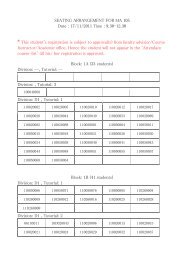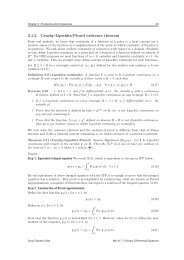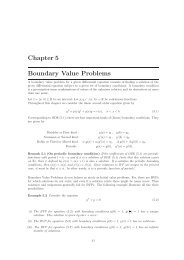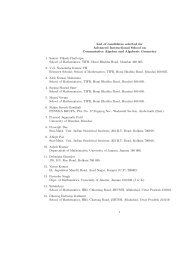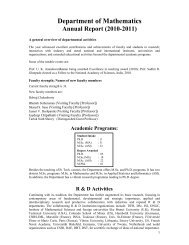the Masters' Thesis of S. Sundar
the Masters' Thesis of S. Sundar
the Masters' Thesis of S. Sundar
You also want an ePaper? Increase the reach of your titles
YUMPU automatically turns print PDFs into web optimized ePapers that Google loves.
Pro<strong>of</strong>. It is clear that πl(M) commutes with πr(M). Let T ∈ πr(M) ′<br />
. Let<br />
x = T(1). Now T(y) = Tπr(y)(1) = πr(y)(T(1)) = xy = πl(x)(y). Hence<br />
T = πl(x) ∈ πl(M). This completes <strong>the</strong> pro<strong>of</strong>. �<br />
Henceforth we identify M with πl(M). Now πr(N) ⊂ πr(M). Note that<br />
πl(M) = πr(M) ′<br />
⊂ πr(N) ′ . Hence starting with a unital inclusion N ⊂ M<br />
toge<strong>the</strong>r with a unital faithful positive trace on M, we obtain ano<strong>the</strong>r unital<br />
inclusion M ⊂ πr(N) ′<br />
.<br />
Definition 7. Suppose N ⊂ M be a unital inclusion <strong>of</strong> finite dimensional<br />
C⋆ algebras. Let tr be a faithful, unital, positive trace on M. Then <strong>the</strong> inclusion<br />
M ⊂ πr(N) ′<br />
is called <strong>the</strong> basic construction for <strong>the</strong> pair (N ⊂ M,tr).<br />
The main properties <strong>of</strong> <strong>the</strong> basic construction are summarised in <strong>the</strong> following<br />
porposition.<br />
Proposition 8. Suppose N ⊂ M be a unital inclusion <strong>of</strong> finite dimensional<br />
C ⋆ algebras. Let tr be a faithful, unital, positive trace on M. Then,<br />
1. The C ⋆ algebra generated by M and eN in B(L 2 (M,tr)) is πr(N) ′<br />
.<br />
2. The central support <strong>of</strong> eN in πr(N) ′<br />
3. eNxeN = E(x)eN for x ∈ M.<br />
is 1.<br />
4. If Λ is <strong>the</strong> inclusion matrix for N ⊂ M <strong>the</strong>n Λt is <strong>the</strong> inclusion matrix<br />
for M ⊂ πr(N) ′<br />
.<br />
Pro<strong>of</strong>. Let 〈M,eN 〉 denote <strong>the</strong> C⋆ algebra generated by M and eN. We<br />
prove that <strong>the</strong> commutant <strong>of</strong> 〈M,eN 〉 is πr(N). Let T ∈ (〈M,eN 〉) ′<br />
. Since<br />
T commutes with eN, T leaves N invariant. Let x = T(1). Then x ∈ N.<br />
Now T(y) = Tπl(y)(1) = πl(y)T(1) = yx = πr(x)(y). Hence T ∈ πr(N).<br />
This implies 〈M,eN 〉 ′<br />
⊂ πr(N) On <strong>the</strong> o<strong>the</strong>r hand, πr(N) commutes with<br />
M. Since N is invariant under πr(N), it follows that πr(N) commutes with<br />
eN. Hence πr(N) commutes with 〈M,eN 〉. This implies (〈M,eN 〉) ′<br />
= πr(N).<br />
By von Neumann’s double commutant <strong>the</strong>orem, (〈M,eN 〉) = πr(N) ′<br />
.<br />
Let q1,q2, · · · ,qr denote <strong>the</strong> minimal central projections in N. Then <strong>the</strong><br />
minimal central projections <strong>of</strong> (πr(N)) ′<br />
are πr(q1),πr(q2), · · · ,πr(qr). Since<br />
πr(qi)eN(q ⋆ i ) = q⋆ i qi, we have πr(qi)eN �= 0. Thus <strong>the</strong> central support <strong>of</strong> eN<br />
in 〈M,eN 〉 is 1.<br />
Let x ∈ M be given. On N ⊥ , eNxeN = 0 = E(x)eN. Let n ∈ N be given.<br />
Then eNxeN(n) = E(xn) = E(x)n = E(x)eN(n). Hence eNxeN = E(x)eN.<br />
For a C ⋆ algebra A, Let A op denote <strong>the</strong> C ⋆ algebra whose underlyind set and<br />
21



